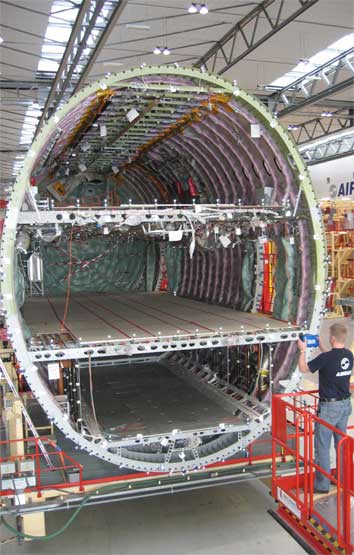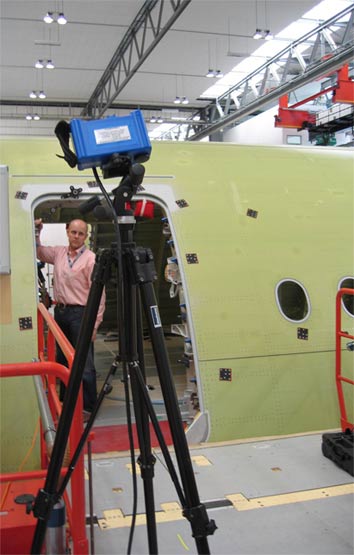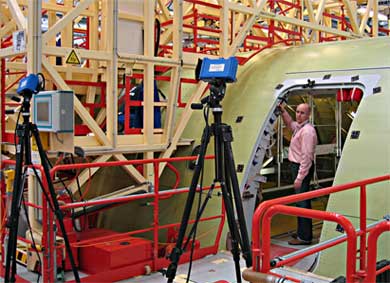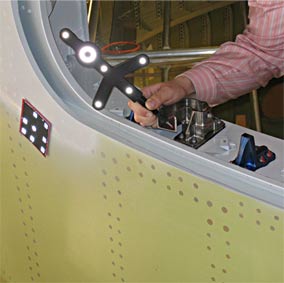High flexible measurement technology at AIRBUS.
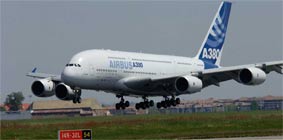
Precise 3D measurements under operational conditions represent a big challenge for quality assurance in aircraft construction. The measurement technology at the AIRBUS plant in Hamburg has met this challenge by using the mobile V-STARS photogrammetric measurement system from GSI. The system impresses the aircraft manufacturer with not only its high flexibility, but above all its measuring accuracy, reliability and ease of use.
AIRBUS utilises the capacities and expertise of 16 locations in France , Spain , Great Britain and Germany . But complete aircraft sections are produced only in Hamburg and St. Nazaire. This unique industrial concept, based on “Centres of Excellence“, has proven to be extremely efficient. “ Hamburg 's share of this project is the manufacture of the front and rear fuselage sections for the AIRBUS models, including the A380. The A320 models also undergo final assembly here, which means the cockpit is joined to the middle section of the fuselage and the wings,” explains Uwe Drohne, Head of Measurement Technology at AIRBUS in Hamburg .
The 15-member measurement technology team of Uwe Drohne represents one group within quality assurance. Its tasks comprise everything having to do with geometric measurement technology. In order to be able to optimally perform all required measuring tasks, the technicians have at their disposal a number of proven systems. The bandwidth ranges from stationary coordinate measuring systems to laser trackers and tachymeters. One measuring system, however, stands out among these instruments – the V-STARS System from GSI.
While it is already frequently used in the aerospace arena in particular, and is gaining in popularity in the automotive industry, it is not very well known in industry in general.
V-STARS is a mobile coordinate measurement system whose use of a single INCA camera (V-STARS/S) or two or more INCA cameras (V-STARS/M) makes possible quick and highly-precise 3D captures. Thanks to photogrammetric technology, the actual measurements are not performed directly at the object, but in digital images taken from various angles. Afterwards, the images are automatically processed by the powerful V-STARS software, and the 3D coordinates of the measured object are calculated. These coordinates can be graphically displayed and analyzed by V-STARS or other software. The stated measuring accuracy of the V-STARS/S system is 5 µm + 5 µm / m.
The Hamburg facility alone has eight V-STARS systems. Additional systems are in use in other AIRBUS plants. “In 1998, the first INCA1 system was made available to Uwe Drohne on a lease basis for one year. During that time, he and his team gathered extensive experience with the system, judged it to be good and finally acquired one. The testing of the special applications of the camera in Hamburg had been the subject of diploma theses. V-STARS made an impression with the accuracy, the expected reliability and manageability of its compact camera. Today, three INCA2 and five INCA3 systems are in use in the measurement technology department,” reports Roland Kinzel, General Manager of GDV Systems GmbH in Bad Schwartau, the sales partner of GSI for the German-speaking countries.
The application possibilities of the V-STARS systems in metrology are diverse. First, there are two series applications. One is the periodic testing of large-scale construction fixtures. These are assembly devices in which parts of aircraft sections are built. The other is fuselage section interface measurements. The interface of each fuselage Hamburg delivers to other AIRBUS plants is measured with the V-STARS system. In addition to these two series measurements, the mobile measurement system performs many other measurements such as on passenger door frames, cargo hold door frames and supports in the aircraft. The measurement technicians have also used the system to perform measurements on the wings or during testing, as well as deformation measurements – the spectrum is very broad.
Figure 1 : Fuselage Section Interface |
Figure 2 : The mobile 3D measurement system in the production area. |
“We answer the question of which of our measuring systems we use for a given application by saying that which is best suited for the purpose. The photogrammetric V-STARS system is very well suited for measurements in unstable environments such as on a wobbly platform. The same applies to measurements in the aircraft and for measuring a large number of points. A classic example is deformation measurements where 2,000 to 3,000 points have to be measured at once“, is how Andreas Kunkel, responsible for photogrammetry in the measurement technology department, describes the primary areas of application of the V-STARS system.
The V-STARS system is also ideally suited for measurements in cases where the technicians in Hamburg have only limited access time – for component and section measurements during their lunch break, for instance. This gives the measuring technicians a window of at least 30 minutes, but in that timeframe the measurement that normally takes 15 to 20 minutes must be completed. Mention should also be made of measurements in tight spatial conditions such as in the cargo compartment of small aircraft, where you can only move in a crouched position and also must perform measurements behind or around pipes. Thanks to the comparatively small camera, the V-STARS system affords the technicians great flexibility.
It is precisely this application that showcases the advantages of the V-STARS compared to the Laser Tracker. The system is not only easier to handle, but is also ready for use more quickly since it doesn't require any warm-up time. Especially for measurements inside an object, when the fuselage is closed and you can only look inside through doors, the Tracker also has disadvantages. One disadvantage of the V-STARS/S system with a single INCA camera, on the other hand, is the fact that the measurements can only be evaluated downstream. Immediate results can be obtained with the V-STARS/M system in online mode. Here two or more INCA cameras are connected, but the measuring accuracy is ‘only' 10 µm + 10 µm / m because of the lower number of images.
The technicians in Hamburg use the V-STARS systems several times a day, 700 times a year for fuselage section interface measurements alone. Add to this about 70 construction site measurements over the course of a year, during which several images are taken, as well as various other uses. Looking at this enormous number of measurements, it is not surprising that the measurement technicians are very impressed by the reliability of the V-STARS systems. Especially when you consider that the technicians travel with the production and have to navigate through tight enclosures, where it is conceivable that the camera may bump against a corner.
Uwe Drohne draws a very positive conclusion: “The V-STARS systems have absolutely met our expectations – especially as concerns accuracy and flexibility. We carried out the applications for which we bought the measuring systems without any problems, and actually discovered various new areas of application for the system. The cameras are easy to operate. After a short training period, you can hand them to someone and be off and running...” Last but not least, the measurement technology efficiency could be improved significantly with the use of the V-STARS systems. With the analogue system used previously, today's tasks could not have been managed, neither in terms of practicability nor speed of data output, let along with the same number or workers.
Figure 3 : Passenger door frame measurement |
Figure 4 : Geometry acquisition using the hand held measurement probe. |
The INCA3 camera, specifically designed and built by GSI to perform high accuracy 3D measurements, combines a proven ultra-high-resolution CCD sensor with an on-board PC based industrial computer to perform measurements in harsh conditions and unstable environments. In order to obtain such performances, GSI imposes not only an unsurpassed opto-mechanical stability inside the camera but also features such as an integrated strobe, or wireless (WIFI) connectivity after a typical ten-to-one image compression.
The confined aspect of the measurement environment of the corners fitting at Airbus is interesting for the
V-STARS system. However, the INCA3 camera is particularly well-suited for in-place measurements of large objects since there is no size restriction of the part to be measured. That makes it possible for V-STARS systems to be used in fields such as Aeronautics, Space, automotive, shipbuilding, power generation, heavy industry, etc
Once INCA3 captures photos (either via hand-held operation or remote control), GSI's proprietary V-STARS software automatically inspects the collected digital images and extracts the required 3D data. This process is fully automated. The measured points can then be compared to their nominals (either point by point or compared to the relating CAD file) or compared to previous measurements (repeatability or capability studies).
INCA3:
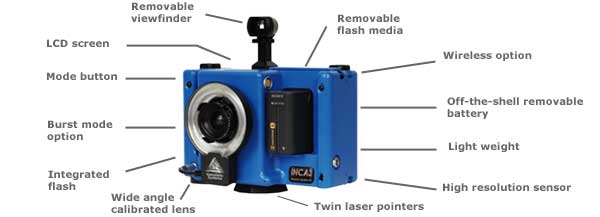
What is Metrology? What is Photogrammetry?
The science of measurement is known as the field of metrology. Engineers, manufacturers, scientists, and quality control technicians utilize measurement technology in their own unique disciplines.
About NTI
NTI manages all aspects of GSI's V-STARS activities in Europe.
About Geodetic Systems, Inc.
Geodetic Systems, Inc. (GSI, www.geodetic.com) is an international supplier of industrial photogrammetry solutions for the industrial measurement/metrology marketplace. GSI develops and markets the V-STARS family of 3D coordinate measurement systems for users involved in measurement and inspection applications in diverse industries such as aerospace, nuclear power, automotive and shipbuilding. INCA3, the company's flagship product, is a state-of-the-art digital photogrammetry camera with many progressive features. GSI distributes its products via a worldwide network of industry partners. The V-STARS systems and the INCA3 camera's distribution in Europe is coordinated by NTI.
For further information contact:
32 route de Seichebriéres
Tel. +33 (0) 2 38 59 30 51 / Fax: + 33 (0) 2 38 59 30 97
Cellular: +33 (0) 6 83 70 89 79
E-mail: nicolas.tanala@v-stars3d.com, website: www.nti-measure.com
__________________________________________________________________________________
INCA3, V-STARS, Picture Perfect Measurements are trademarks or registered trademarks of Geodetic Services, Inc. All other brand and product names are trademarks or registered trademarks of their respective owners.
